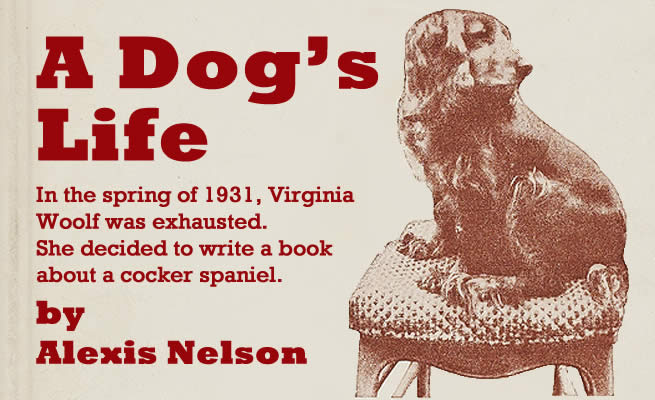 n the spring of 1931, Virginia Woolf was exhausted. She had just completed The Waves, her boldest experiment in form and style yet, and the sustained intensity of the work had worn her out, both mentally and physically. In the thick of it, she’d been ill. In her journal she noted simply, “to lie on the sofa for a week.” Later she added, “Never have I screwed my brain so tight over a book.” Her next project, she promised herself, would not be so demanding. She wanted a “swifter, slighter adventure,” a subject she could “fling off.”
n the spring of 1931, Virginia Woolf was exhausted. She had just completed The Waves, her boldest experiment in form and style yet, and the sustained intensity of the work had worn her out, both mentally and physically. In the thick of it, she’d been ill. In her journal she noted simply, “to lie on the sofa for a week.” Later she added, “Never have I screwed my brain so tight over a book.” Her next project, she promised herself, would not be so demanding. She wanted a “swifter, slighter adventure,” a subject she could “fling off.”
She decided to write a book about a cocker spaniel.
Reading Elizabeth Barrett Browning’s letters while languishing under the stress and illness brought on by The Waves, Woolf had found herself enchanted by repeated mentions of the poet’s pet. Flush had been a pedigree cocker spaniel like the Woolfs’ own dog, Pinker (herself a gift to Virginia from Vita Sackville-West). Woolf imagined writing a “biography” of Browning’s dog—one that, like Orlando, would play with the biographical form. It would be light, witty, and bright. It would bring relief, release.
Of course it did not prove so simple. Woolf had intended Flush to be, in part, a playful inside joke to her dear friend and rival, Lytton Strachey, whose biography Eminent Victorians had brought him literary fame. It also represented a kind of reckoning with another famous biographer: her father, Leslie Stephen, who had cast such a heavy intellectual shadow over his daughter during his lifetime that years after his death she reflected: “His life would have entirely ended mine. What would have happened? No writing, no books;--inconceivable.” Leslie Stephen died of stomach cancer when Virginia was 22. Shortly after she began working on Flush, Lytton Strachey died suddenly of the same disease. The joke of Flush had been spoiled.
She doubted herself, and the project. In December of 1932, reading over what she’d written so far, she declared it a “waste” and a “bore.” She now judged the book’s subject to be both “too slight and too serious.”
“That silly book Flush,” she calls it a few months later. “Oh what a waste of time.”
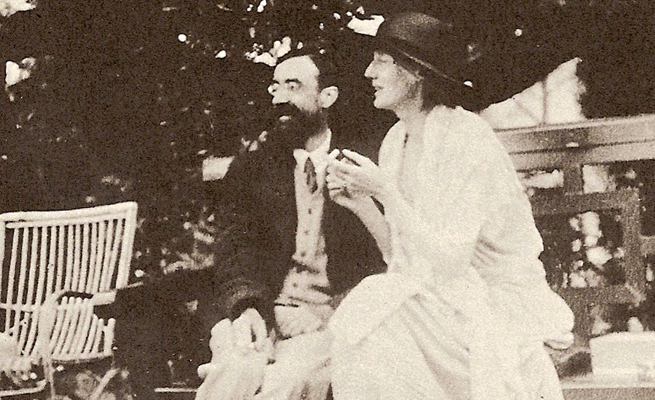 Lytton Strachey and Virginia Woolf, 1923.
Lytton Strachey and Virginia Woolf, 1923.
 e want to know what our pets are thinking. Search “animal psychology” on Amazon.com, and you’ll get nearly 7,000 results (around the same number, it turns out, as a search for “Virginia Woolf” returns). A Google search for “Understanding your dog” produces about 50 million hits. Sometimes, I look my dog in the face and am almost certain she is about to speak. But she never does. So the gulf between us remains; and the doggie-psychology industry booms.
e want to know what our pets are thinking. Search “animal psychology” on Amazon.com, and you’ll get nearly 7,000 results (around the same number, it turns out, as a search for “Virginia Woolf” returns). A Google search for “Understanding your dog” produces about 50 million hits. Sometimes, I look my dog in the face and am almost certain she is about to speak. But she never does. So the gulf between us remains; and the doggie-psychology industry booms.
And yet, books with dog-protagonists are never quite taken seriously as literature. Consider The Call of the Wild: a dark, violent book, and one of Jack London’s best, it has nonetheless been relegated for years to Scholastic Book Club flyers for fourth and fifth graders. That’s great for eleven-year-olds, but when I recently wanted to teach The Call of the Wild in a college-level American Literature course, I had a hard time finding an edition that didn’t come with embarrassing illustrations, or a reading guide in the back with suggestions like, “Imagine that you are a gold prospector during the Klondike gold rush. Draw a map of Alaska, and plan your route!”
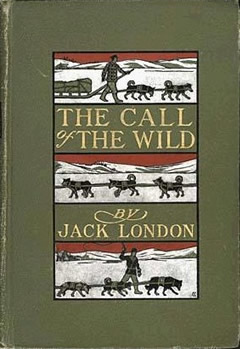 Part of the problem is that we tend to assume that any tale about an animal must have been written for children. And it’s true, there is a time in most little girls’ lives—probably for many boys as well—when nothing stirs their empathy and imagination quite so much as stories about animals. Maybe this is because an animal’s perspective is closer to the ground, like a child’s; or because animals are the only creatures with less power than they; or maybe it’s because we know animals through symbolic actions rather than language, and language is still too wobbly and uncertain a vehicle for the thoughts and feelings of children. (For grown-ups, too, I might argue, although by adulthood we’ve become more accustomed to the all-too-frequent inadequacy of words.)
Part of the problem is that we tend to assume that any tale about an animal must have been written for children. And it’s true, there is a time in most little girls’ lives—probably for many boys as well—when nothing stirs their empathy and imagination quite so much as stories about animals. Maybe this is because an animal’s perspective is closer to the ground, like a child’s; or because animals are the only creatures with less power than they; or maybe it’s because we know animals through symbolic actions rather than language, and language is still too wobbly and uncertain a vehicle for the thoughts and feelings of children. (For grown-ups, too, I might argue, although by adulthood we’ve become more accustomed to the all-too-frequent inadequacy of words.)
On the other hand, maybe it’s just that doggies are cute.
My own passion for dog books was reignited about a year and a half ago, when my husband and I decided to adopt a puppy. Percy was 10 weeks old the first time I held her, silky and shivering, against my chest. A moment before, she had been a stroke of reddish-gold fur in somebody else’s arms; now she was my pet. My husband and I took her home with us, where she promptly piddled on the floor, then hid between my husband’s boots. I called to her. She made a tentative gesture, a faint movement of her front paw against the ground. We looked at each other.
Somehow I had not been prepared for this; somehow, in all the time my husband and I had talked of getting a puppy, and looked at photos of puppies online, and cooed and fussed over other people’s puppies, I had not imagined what it would actually feel like to suddenly have this dog in my life, this strange creature that was now to share my home with me. In a way, it was not so very different from suddenly having a husband—for that, too, was new. And just as I didn’t want to read handbooks on being married, I wasn’t interested in books on dog psychology, either. What I wanted—what I always seem to want when experiencing something new, something that feels both significant and mysterious—was stories.
 lush opens with a delightful bit of silliness, a long digression on the dog’s noble origins that pokes fun at the English aristocracy. (At one point, Woolf laments the fact that there is no “Man Club” as there is a “Spaniel Club,” to set concrete standards by which to judge the human animal.) But like most dog books, Flush is, at its core, a romance; and so the storydoesn’t really take off until Cocker and Poetess meet.
lush opens with a delightful bit of silliness, a long digression on the dog’s noble origins that pokes fun at the English aristocracy. (At one point, Woolf laments the fact that there is no “Man Club” as there is a “Spaniel Club,” to set concrete standards by which to judge the human animal.) But like most dog books, Flush is, at its core, a romance; and so the storydoesn’t really take off until Cocker and Poetess meet.
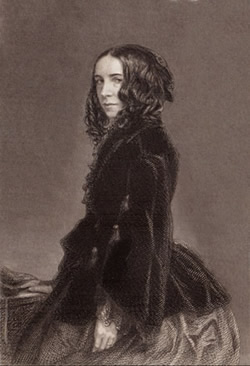 I’m not sure why, but I find it somehow comforting to know that the phenomenon of dogs and their owners resembling one another has existed since at least the mid-19th century. When Elizabeth Barrett (Browning has not yet come into the picture at this point) and Flush first regard each other, both immediately recognize “a likeness” between them. And it must be said that Elizabeth Barrett Browning truly did resemble a cocker spaniel. The loose curls framing her face in typical Victorian fashion bear striking similarity to the long, curly ears for which spaniels are known. There’s something, too, in the poet’s large and rather wide-set eyes—a look that is direct and at the same time a little tentative, a little withholding.
I’m not sure why, but I find it somehow comforting to know that the phenomenon of dogs and their owners resembling one another has existed since at least the mid-19th century. When Elizabeth Barrett (Browning has not yet come into the picture at this point) and Flush first regard each other, both immediately recognize “a likeness” between them. And it must be said that Elizabeth Barrett Browning truly did resemble a cocker spaniel. The loose curls framing her face in typical Victorian fashion bear striking similarity to the long, curly ears for which spaniels are known. There’s something, too, in the poet’s large and rather wide-set eyes—a look that is direct and at the same time a little tentative, a little withholding.
But Flush belongs to the outdoors, to the fresh air and everything that is natural and free. Barrett, who suffered for much of her life from a mysterious and untreatable illness, belongs to the bedroom—and not just any bedroom, but the Victorian bedroom, with its overstuffed furniture, dark wood paneling and heavy curtains. Despite the similarities between Miss Barrett and Flush, “Hers was the pale worn face of an invalid, cut off from air, light, freedom. His was the warm ruddy face of a young animal; instinct with health and energy.” They are the same, yet different: as with any couple, this is partly where the attraction comes from. “Could it be,” Woolf wonders, “that each completed what was dormant in the other?”
Woolf writes about the bond between Miss Barrett and Flush in a way that manages to be moving and tender, without giving Flush credit for feelings too human to be believed. He experiences his growing attachment to Miss Barrett as “an uncomfortable yet thrilling tightness”—as beautiful and precise a description of dawning love as I’ve ever read. Despite their connection, though, “vast gaps” in understanding necessarily separate the two creatures. “Sometimes,” Woolf writes, “they would lie and stare at each other in blank bewilderment.”
Why, Miss Barrett wondered, did Flush tremble suddenly, and whimper and start and listen? She could hear nothing; she could see nothing; there was nobody in the room with them…Flush was equally at a loss to account for Miss Barrett’s emotions. There she would lie hour after hour passing her hand over a white page with a black stick; and her eyes would suddenly fill with tears; but why? …There was no sound in the room, no smell to make Miss Barrett cry.
They can’t communicate in any of the ways most natural to either of them. Yet I can’t help but think that the “blank bewilderment” with which Miss Barrett and Flush sometimes regard each other is nearly as often felt in human relationships. How often has my husband, for instance, said or done something that’s made me stop, and stare, and wonder: who are you, really? Not that my husband is a particularly mysterious or complex creature. But look at him there, on the other end of the sofa. He is reading; now he looks up, stares for a moment at the empty space a few inches in front of his forehead; slowly, with two fingers, he scratches his cheek. If I ask him what he’s thinking about, he’ll probably say, “not much”—and he may even be telling the truth. What’s truly going on in that head of his, what it really feels like to dwell inside his consciousness, I’ll never know—no matter how close we become, or how many words he uses to try to explain it to me.
This, in a way, is the central tension of Flush, although the action of the novel involves everything from a dramatic dog-napping to Elizabeth Barrett and Robert Browning’s courtship and eventual elopement. Miss Barrett and Flush share a bond that is real and profound; yet they can never quite understand each other, or know each other. But what does it really mean to know another being, as intimately—or nearly so—as one knows oneself? What would that look like? Woolf recognizes that the main thing separating dog and mistress is the fact that “they could not communicate with words.” And yet might that, she wonders, “lead also to a peculiar intimacy? After all…do words say everything? Can words say anything? Do not words destroy the symbol that lies beyond the reach of words?”
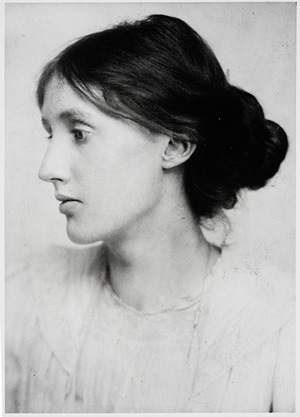 Woolf never directly answers these questions. But over the course of the novel, Miss Barrett and Flush draw nearer each other, as shegradually becomes a bit more doggie-like, and he, a bit more human. In his beloved mistress’s dusky back bedroom, Flush quickly learns “to resign, to control, to suppress the most violent instincts of his nature,” in exchange for the privilege and pleasure of nestling on the sofa at Miss Barrett’s feet. Over time, “lying with his head pillowed on a Greek lexicon, he came to dislike barking and biting; he came to prefer the silence of the cat to the robustness of the dog; and human sympathy to either.” For her part, Miss Barrett begins to feel closer to the natural world through Flush’s presence. One afternoon, while lying upon the sofa in an oh-so-Victorian state of melancholy torpor, she is rustled from a daydream by the press of a furry face against her own, and for a moment, she imagines that Flush is Pan, and she a nymph. No longer an invalid confined to an invalid’s couch, she and “Pan” are let loose in an Arcadian grove. Woolf didn’t invent this flight of fancy; she lifted it directly from one of the Browning letters that had so charmed her, as she’d lain reading them on her own invalid’s couch.
Woolf never directly answers these questions. But over the course of the novel, Miss Barrett and Flush draw nearer each other, as shegradually becomes a bit more doggie-like, and he, a bit more human. In his beloved mistress’s dusky back bedroom, Flush quickly learns “to resign, to control, to suppress the most violent instincts of his nature,” in exchange for the privilege and pleasure of nestling on the sofa at Miss Barrett’s feet. Over time, “lying with his head pillowed on a Greek lexicon, he came to dislike barking and biting; he came to prefer the silence of the cat to the robustness of the dog; and human sympathy to either.” For her part, Miss Barrett begins to feel closer to the natural world through Flush’s presence. One afternoon, while lying upon the sofa in an oh-so-Victorian state of melancholy torpor, she is rustled from a daydream by the press of a furry face against her own, and for a moment, she imagines that Flush is Pan, and she a nymph. No longer an invalid confined to an invalid’s couch, she and “Pan” are let loose in an Arcadian grove. Woolf didn’t invent this flight of fancy; she lifted it directly from one of the Browning letters that had so charmed her, as she’d lain reading them on her own invalid’s couch.
Miss Barrett’s fantasy illuminates our pull toward animals in general, and dogs in particular. Though they live with us, they seem always to belong to Arcadia—that fabled land of happy herdsmen. Their lives appear simple, uncomplicated. How attractive a dog’s frank, physical existence can seem—especially to a writer, who spends so much of her time in the disembodied realm of language. And even more so, I imagine, to a writer whose own physical existence is limited by illness. An Elizabeth Barrett, for instance, or a Virginia Woolf.
Ultimately, though, it’s man—not beast—that draws Miss Barrett from her sick room, out into the rush of life. Elizabeth Barrett and Robert Browning courted and wed in secret, rightly fearing her controlling father’s disapproval (after learning of the marriage, he immediately disinherited Elizabeth). Following the wedding, the Brownings moved to Italy—Flush, naturally, in tow. In the warm, vibrant atmosphere of their new home, Flush looks on in astonishment as a profound change comes over his mistress, who has been sickly and sad and shut up for most of her adult life:
It was not merely that she called herself Mrs. Browning now…She was a different person altogether. Now, for instance, instead of sipping a thimbleful of port and complaining of a headache, she tossed off a tumbler of Chianti and slept the sounder…Then instead of driving in the barouche landau to Regent’s Park she pulled on her thick boots and scrambled over rocks. Instead of sitting in a carriage and rumbling along Oxford Street, they rattled off in a ramshackle fly to the borders of a lake and looked at mountains; and when she was tired she did not hail another cab; she sat on a stone and watched the lizards.
Mrs. Browning no longer needs Flush to put her in touch with the natural world, or her own animal self; “she had found Pan for herself among the vineyards and the olive trees.” She also finds him, we must assume, in the bedroom—not a Victorian bedroom, this time, but a sunny Italian bedroom, with its windows thrust open and a hot breeze circling through.
Flush, too, becomes more independent in Italy, more of what one might call a “real dog.” While Mrs. Browning throws back her tumblers of Chianti and scrambles over rocks, Flush freely roams the dusty yellow streets of Florence, cavorting with various mongrels whose sordid family trees would surely cause officials of the Spaniel Club to shudder. Both Flush and Mrs. Browning delight in a new way of being in Italy, a new kind of happiness. It’s the sort of happiness that’s inspired by sunlight and fresh air, that’s felt deep in the bones and churns through the veins. It’s the sort of joy we imagine our dogs must feel as we watch them tearing down the beach or bounding across a grassy field, leaping into the air as they go, propelled, it seems, by nothing more and nothing less than the thrill of their own aliveness.
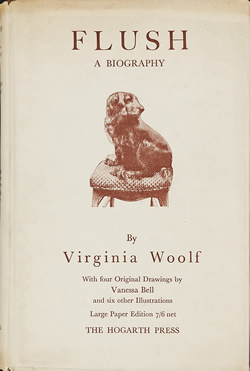
 s the publication date of Flush neared, Woolf’s anxieties over it intensified. She now not only worried that the book was a failure; she also feared its success. She dreaded the kind of praise she imagined it would receive. “Charming, delicate, ladylike,” she thought it would be called.
s the publication date of Flush neared, Woolf’s anxieties over it intensified. She now not only worried that the book was a failure; she also feared its success. She dreaded the kind of praise she imagined it would receive. “Charming, delicate, ladylike,” she thought it would be called.
“I must not let myself believe that I’m simply a ladylike prattler,” she urges herself in her journal, just days before the book is due to come out. “For one thing, it’s not true.” Perhaps she thought of her father, the serious critic and scholar. How would he have judged the project?
Is Flush, as its author feared, a silly book? It certainly is playful, and funny, and yes, “charming.” Woolf may have had it right when she called it “slight”—especially when compared with her other work. It lacks the dizzying ambition of, say, her next novel, Night and Day, in which she aimed at capturing nothing less than “the whole of the present society…in short, a summing up of all I know, feel, laugh at, despise, like, admire, hate and so on.” Still, Flush is, of course, about more than just a cocker spaniel. On one level, its subject is writing itself. A writer attempts to convey, through empathy and imagination, what it is like to live inside of someone else’s skin (or fur). As readers, we too make an imaginative leap into another’s consciousness. In this way, it’s through the intimacy of storytelling that we come closest to bridging the gulf in understanding that inevitably separates us from one another, whether or not we belong to the same era, country, class, gender, or even species.
Woolf’s predictions about how Flush would be received both were and weren’t correct.The book sold extremely well upon its release—better, in fact, than any of her other work to date. But today, it is one of Virginia Woolf’s least-known works, largely ignored by critics and academia. It’s laughable now to imagine Flush defining Woolf’s career in any way. Instead, it turned out to be a book that was enjoyed in the moment but quickly forgotten—similar, I like to think, to the way dogs experience their days. In the spring issue, Alexis Nelson wrote about scarves and hippie skirts. In the fall 2010 issue, she described Gustave Flaubert's disastrous workshop experience.
In the spring issue, Alexis Nelson wrote about scarves and hippie skirts. In the fall 2010 issue, she described Gustave Flaubert's disastrous workshop experience.



